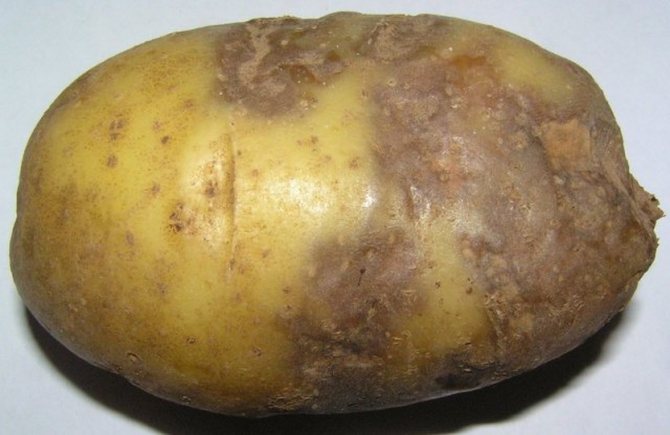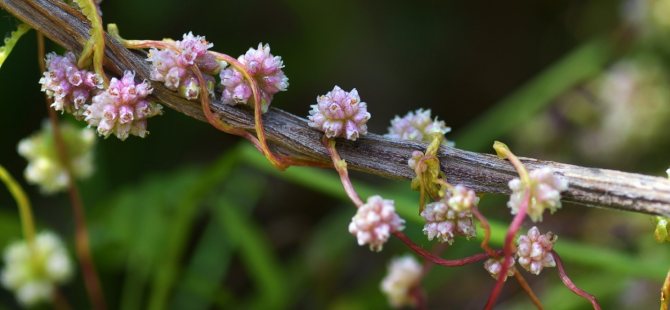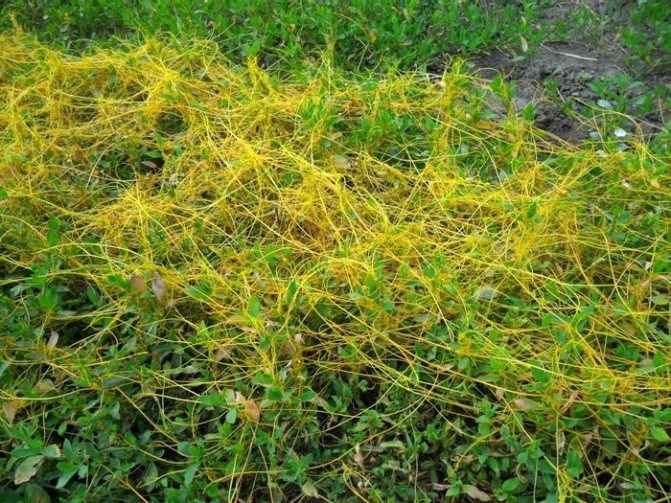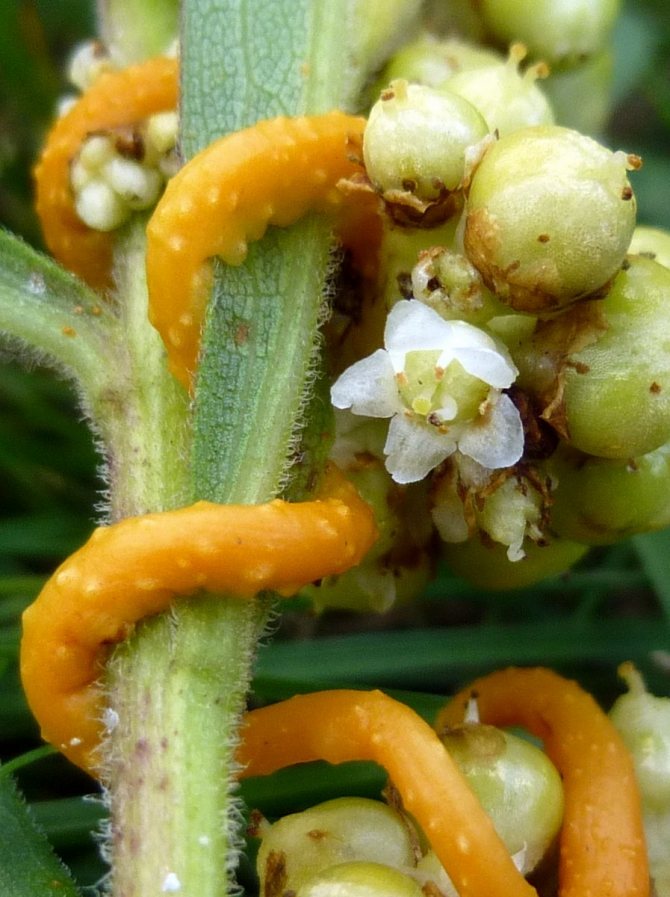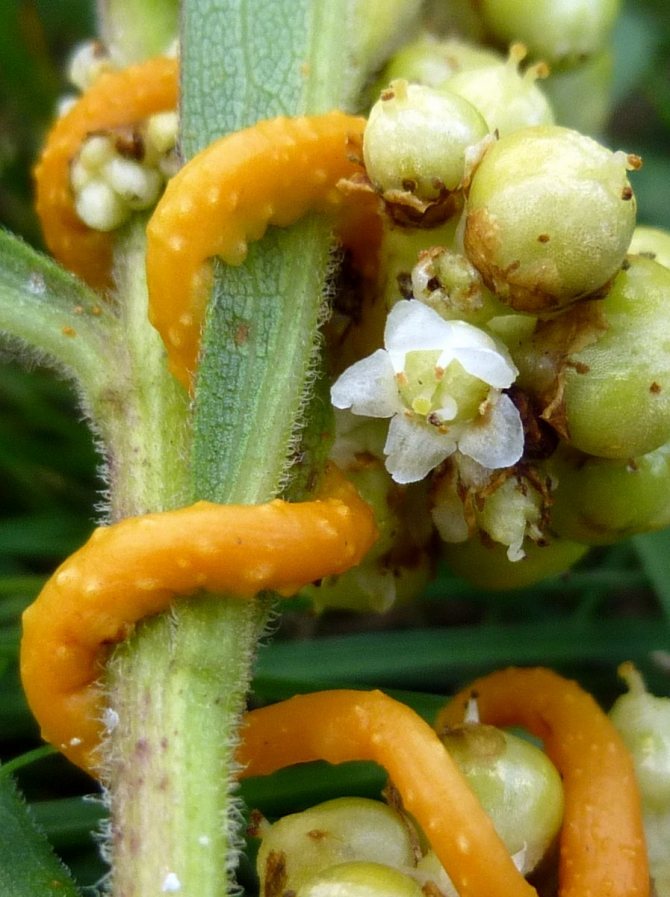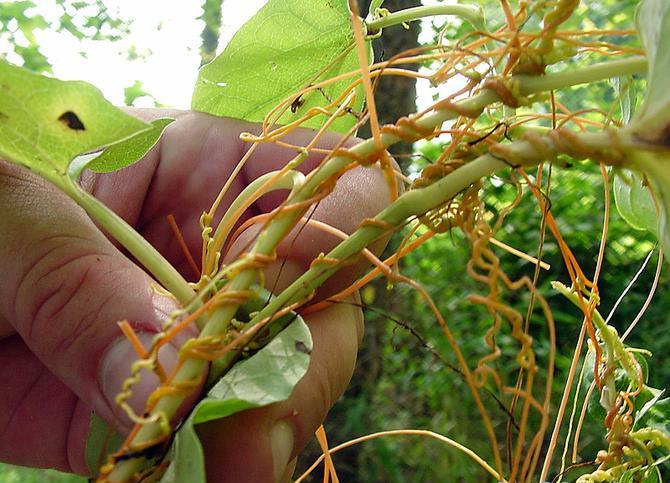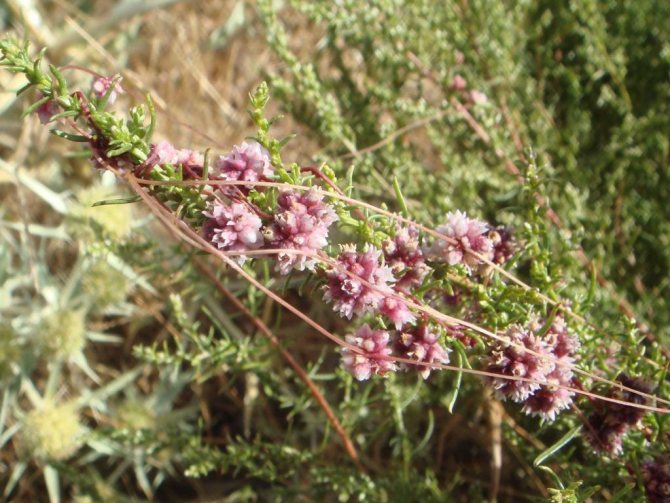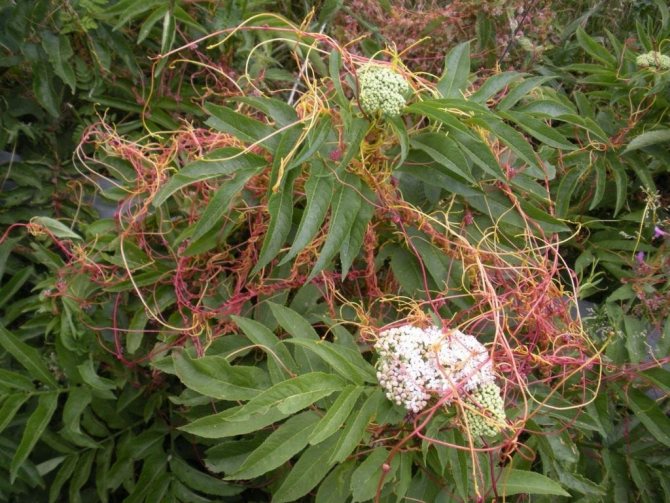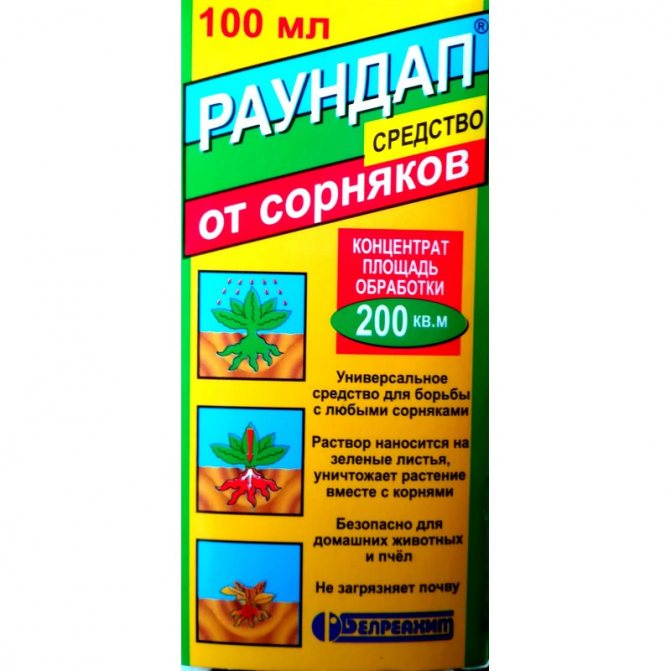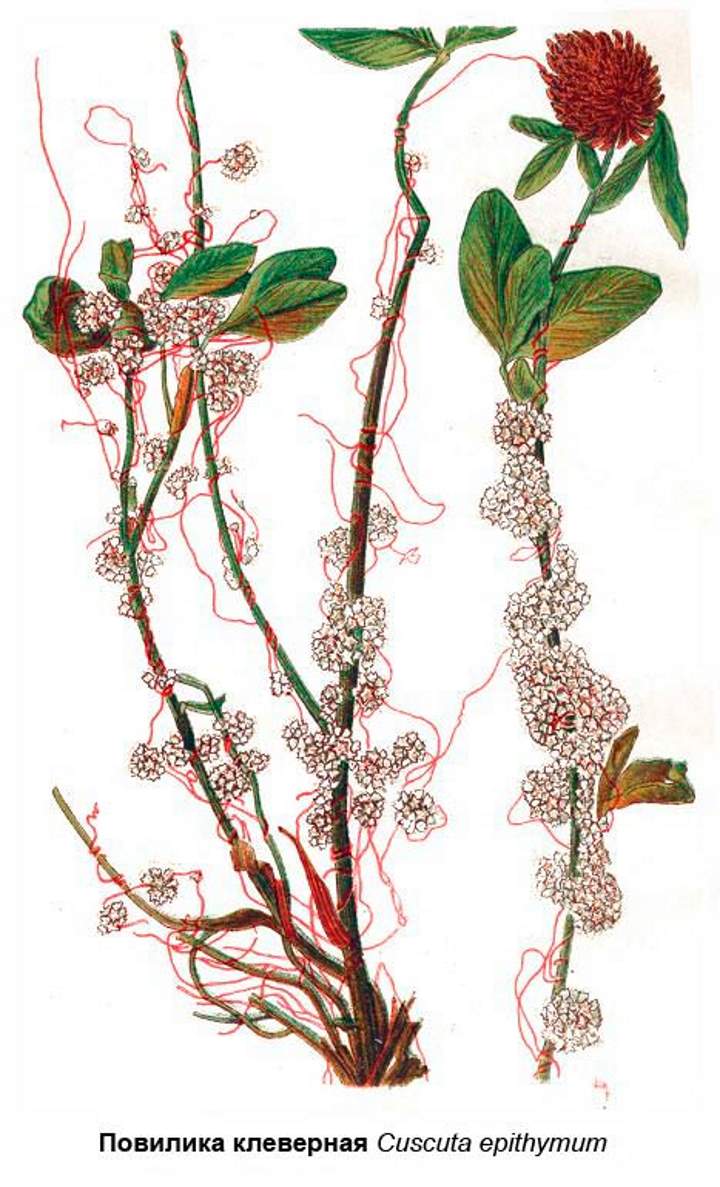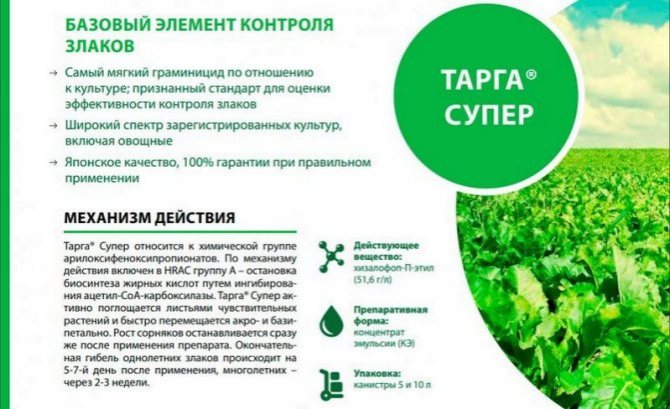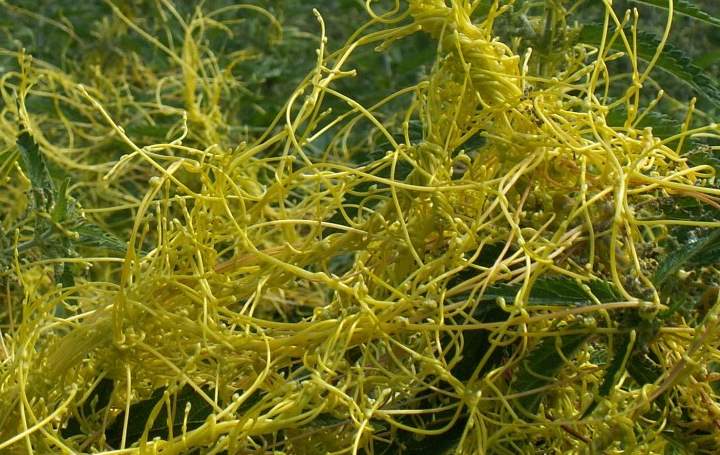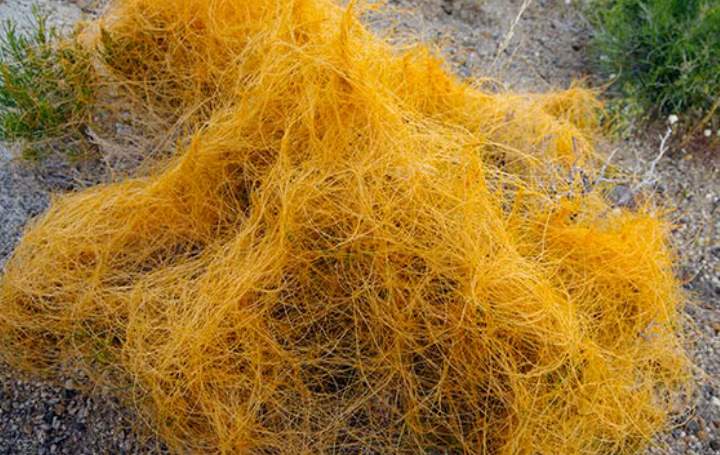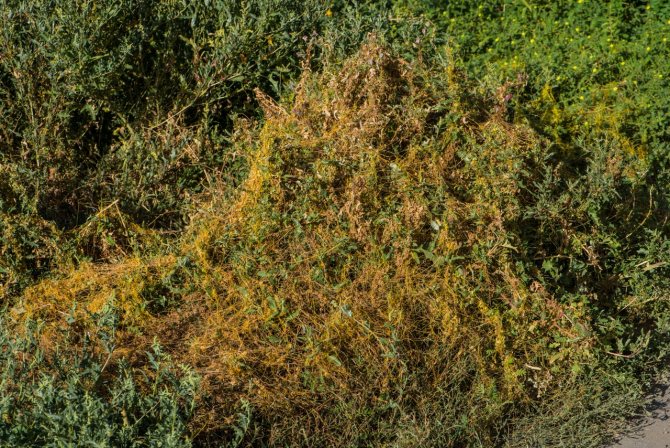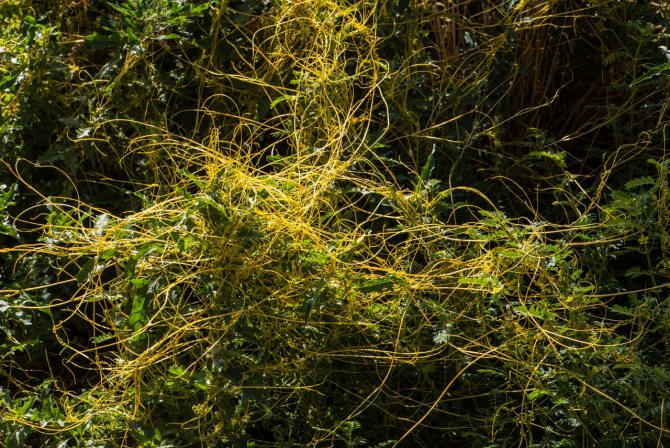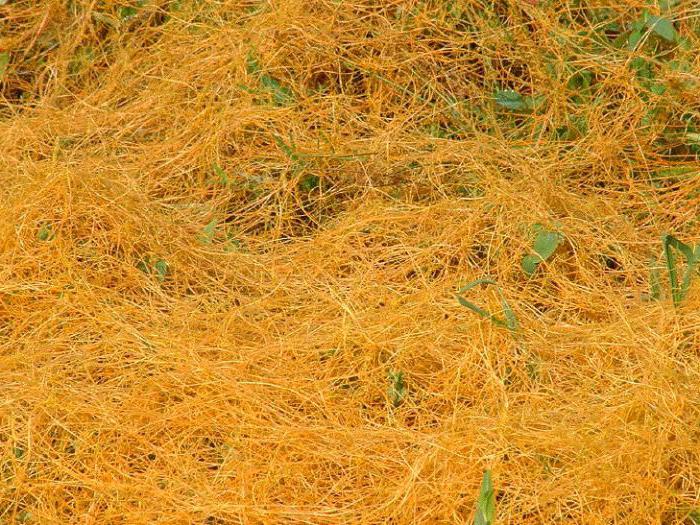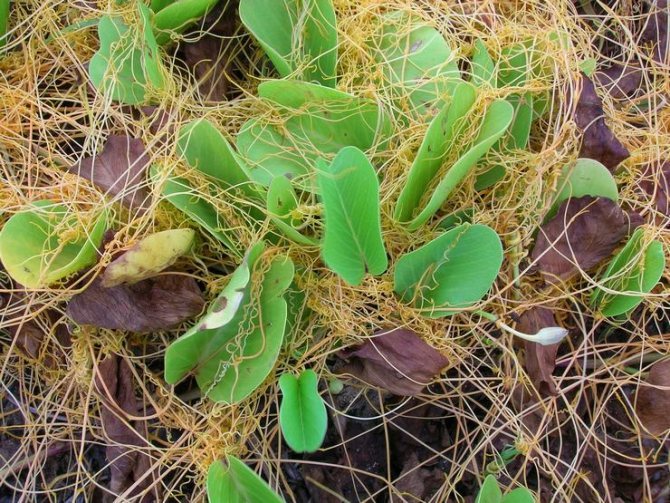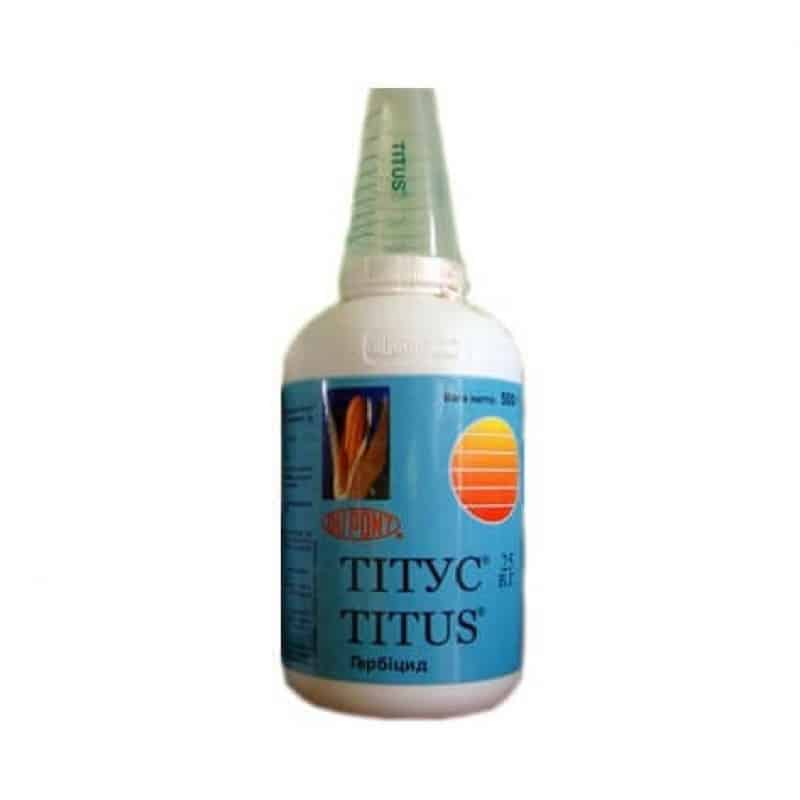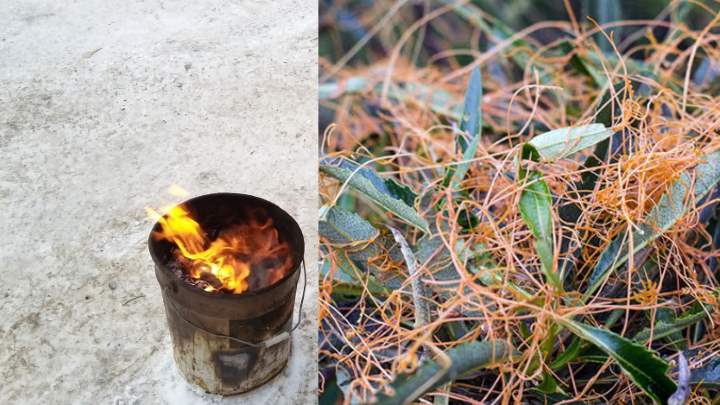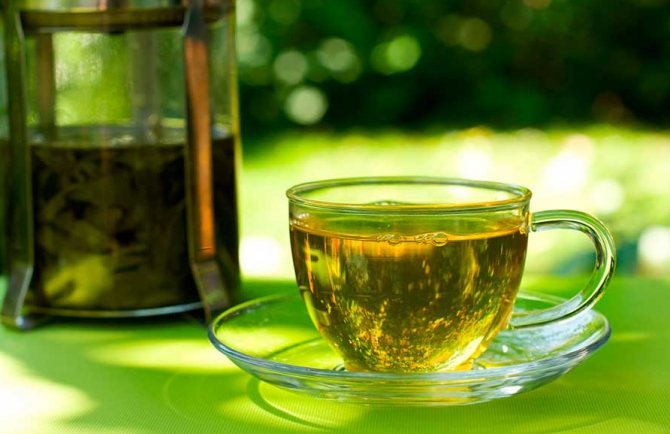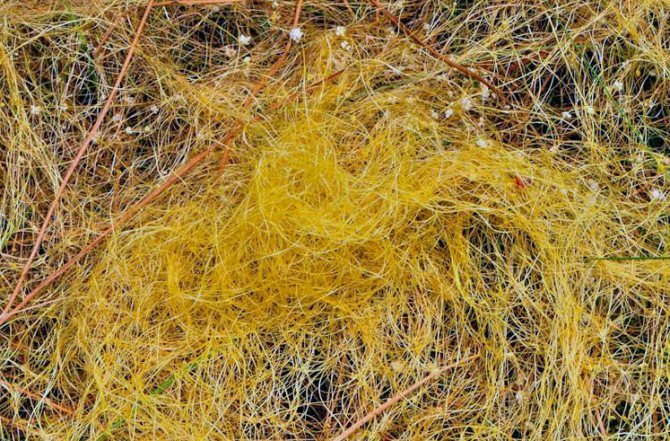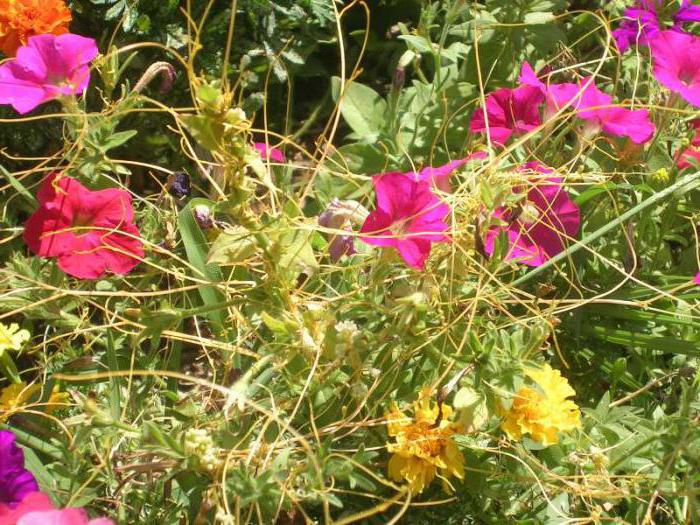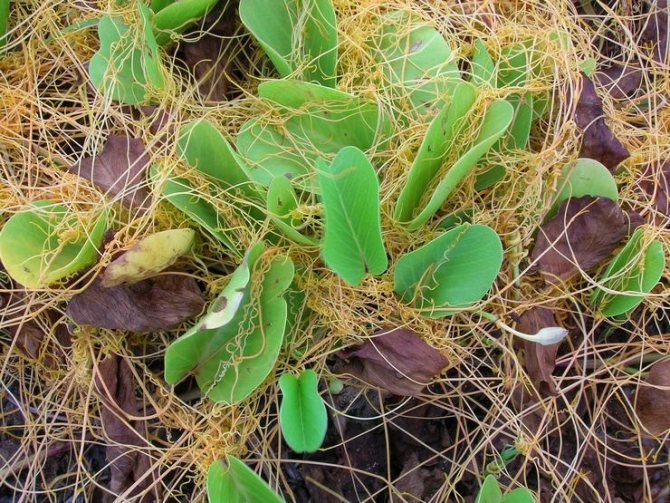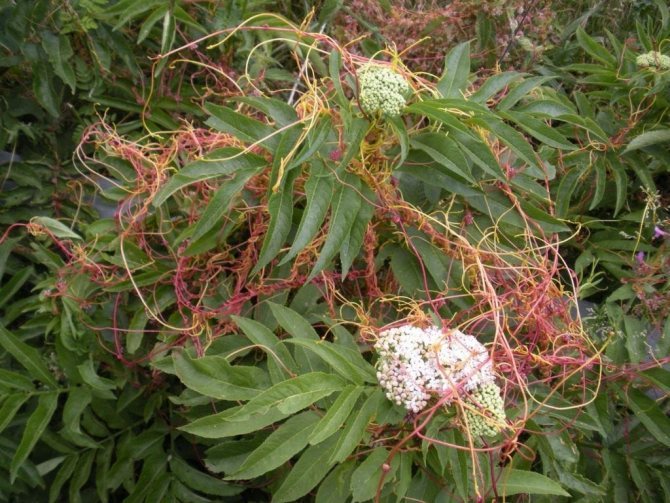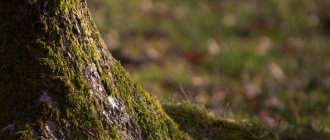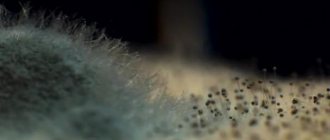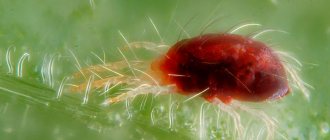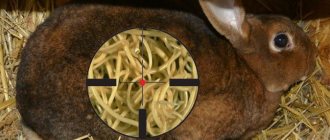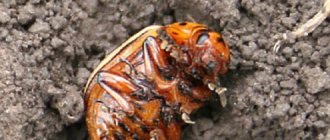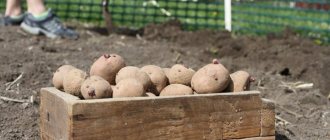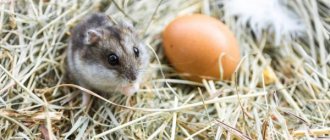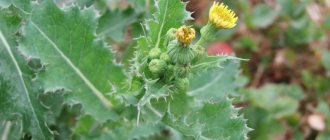General information
Dodder is a cunning parasite that disguises its seeds, which increases the risk of planting it along with the rest of the plants sowing in spring. Dodder seeds have a high viability - they do not die, despite the harsh weather conditions, they survive even if they enter the digestive tract of animals. This ensures the germination of dodders for up to 10 years or more.
In the common people, dodder is called dodder or loach. There are more than 100 species in total. Dodder is an imported weed that originated in North America.

A climbing annual parasitic herb lacking green leaves and roots
Description
Dodder weed originated in the South American and African tropics. Then the plant took over the territories located to the north and south of them. Now there are 171 known varieties of this most dangerous pest. Dodder (Cuscuta) belongs to the family Convolvulaceae.
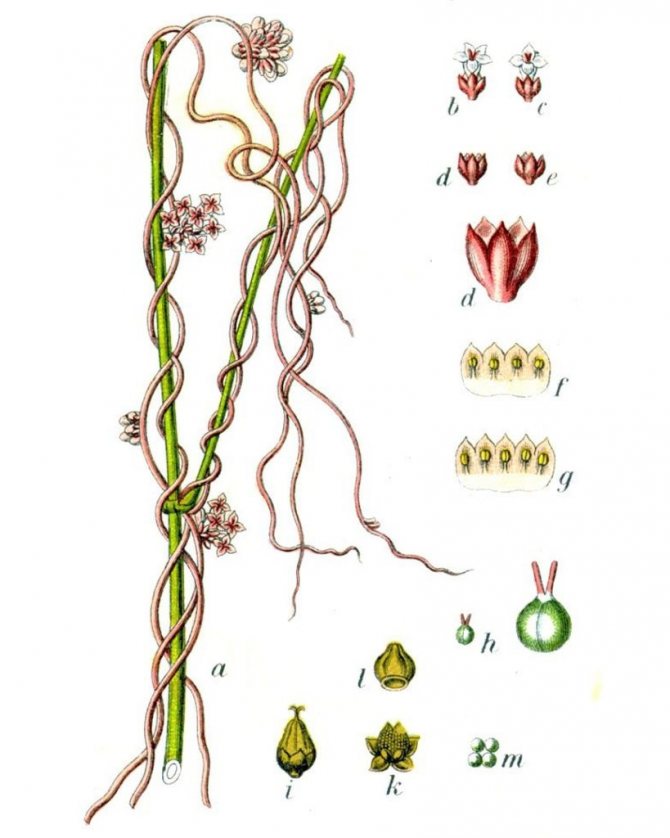

In structure, the weed is similar to a liana - it does not have a root system and leaves
Characteristics of the species
Dodder is a terrestrial plant parasite. It has no roots or leaves. Therefore, it is incapable of independent photosynthesis of chlorophyll.
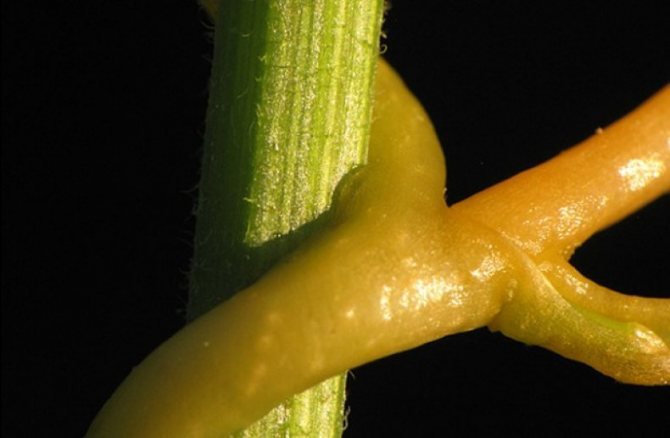

With the help of suckers, the parasite is held on the donor and pumps out nutrients from it
Features:
- The body of the plant is a filamentous stem. It is curly, smooth or covered with warty growths, with barely noticeable rudiments of scaly sheets.
- Body color - yellow, yellow-green or with a reddish tint.
- Dodder is fixed on the donor plant and pumps out nutrients from it with the help of special organs of the haustoria suckers.
- The body of the weed is covered with many small, sessile, or flowers placed on short stalks.
- The reproductive organs have a double perianth. They can be white, pale pink, light green. Petals are grouped into inflorescences in the form of a ball, ear or ball. All types of dodder bloom from mid-July to late August.
- The fruits of the weed are honeycomb or rough inside boxes with 2–5 round or oval seeds with a section of 1–3 mm.
- The sprouts of the parasite first feed on the reserves accumulated in the seeds. Then they begin to crawl in search of the "master".
10 thousand
Appearance
Dodder has no leaves. Its main component is a cord-like stem. The color ranges from yellow to orange and red.
On the stem, the dodder has pink, white or greenish flowers that form inflorescences. In the future, they form a fruit - a box with seeds inside, which have an uneven surface. The embryo has a spiral shape, which lacks a root.
An interesting fact is that immature plant seeds have the fastest germination rate than mature ones. This ensures good germination of the dodder for many years.
Plant danger
Why is dodder dangerous? This species of loach has a rapid growth, covering whole tracts of different crops. One seed of this weed is enough to infect 5-6 square meters of soil. A good turgor of the stem allows plant fragments to remain viable for several more days, while continuing to parasitize.
The flora infected with dodder begins to dry quickly, become covered with mold; soon she loses all vital juices and dies.There is also a high danger for perennial plants - dodder parasitizing them leads to a decrease in their frost resistance and productivity.
Habitat
The tropics of Africa and America are considered the birthplace of dodders. Over time, the plant was able to adapt to other living conditions. As a result of the evolution of the weed, more than two hundred varieties have appeared, inhabiting the territories of more than 160 countries in the world. More than 3 dozen varieties of this plant have been found in Russia, which lives almost everywhere from Siberia to the Far East.
Dodder parasitizes the following crops:
- forage grasses (mainly alfalfa, clover)
- legumes,
- melons,
- vegetable,
- roots,
- berry-growers,
- fruit trees and shrubs,
- grapes,
- some types of garden flowers.
Healing properties
Despite the fact that dodder is a weed, when used correctly, it has a number of medicinal properties. Various decoctions, tinctures, and even ointments for topical use are prepared from it.
Dodder has the following healing effects:
- analgesic;
- hemostatic;
- diuretic;
- laxative;
- anti-inflammatory;
- immunomodulatory;
- antiplatelet.
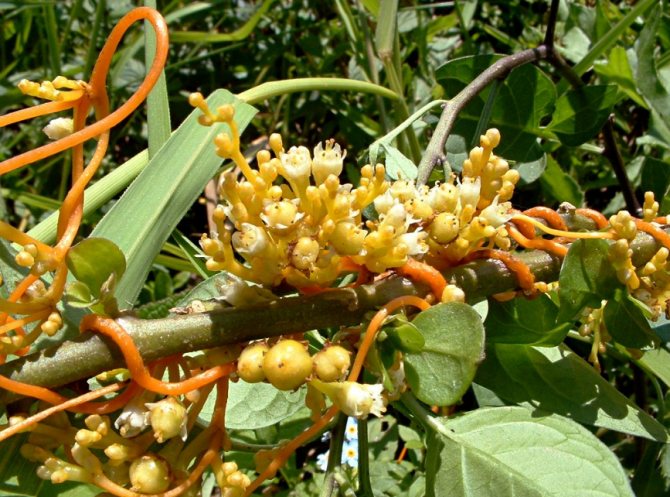

In folk Indian, Tibetan and Chinese medicine, the plant is used as a means of stimulating sexual potency, as well as a diuretic, astringent, sokogonic, anti-inflammatory, anti-inflammatory agent.
Due to its many useful properties, this plant fights such pathologies as alcoholism, cholestasis, viral diseases, hyperthermia, toothache, painful menstruation.
It is known that in combination with other representatives of the flora, it effectively fights against oncological pathologies.
Dodder control
In order to protect your garden or vegetable garden from a harmful plant, there are various control measures. Let's take a closer look at how you can get rid of the dodder - a weed plant.
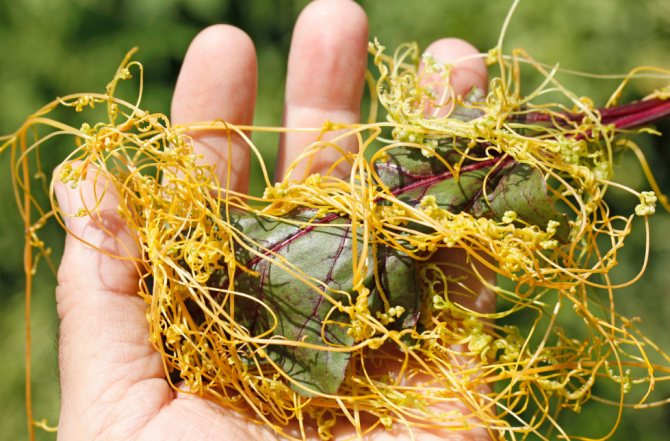

In the fight against dodder, it is necessary to prevent its seeds from ripening. Otherwise, it will be more difficult to defeat her.
Preventive measures
Prevention plays a huge role in weed control. One of the main precautions is pre-sowing selection of seeds - if a dodder is found, it is undesirable to collect seeds from this area for the next sowing.
The second method of prevention is soil cleansing, since it is it that contains the bulk of the seeds of the weed plant. For this, the land is plowed to a sufficient depth.
It is possible to cleanse the soil by stimulating the growth of the dodder and then removing it. The sprout of the weed provokes abundant watering, after which, not finding food on bare soil, it dies.
The most effective prevention method is sowing oats or wheat immediately after the destruction of weed sprouts - on these crops, dodder cannot parasitize.
Drugs
For many years, they tried to destroy the dodder with sulfuric acid, copper sulfate, kerosene - but such methods did not produce an effect. Currently, the only drugs used to kill this weed are herbicides.
Distribution in Ukraine
North America is considered the homeland of the field dodder, a plant of the parasite, from where it spread throughout the world, mainly along with the seeds of various crops. In Europe, it was discovered around 1900, and already in 1914 this quarantine emigrant aggressor "registered" in Ukraine, in the Odessa region. It was here that dodder naturalized and spread rapidly with unrefined alfalfa and clover seed.
The last century was extremely favorable for the "settling" of this dangerous adventive species, so now it is found in all soil and climatic zones of the country.According to the latest data from the State Veterinary and Phytosanitary Service of Ukraine (as of 01.01.2014), the area of dodder field covers almost all areas of the Steppe, Forest-Steppe (with the exception of Ternopil and Cherkasy regions.
It should be noted that in the early 2000s, the area of farmland infested with field dodder reached almost 70 thousand hectares. Therefore, as we can see, over the past decade, thanks to the competent implementation of a complex of quarantine measures to localize and eliminate foci of this weed, the areas infested with it have more than halved.
In addition, on the territory of Ukraine, three more types of field dodder are limitedly distributed: Leman's dodder - 4.62 hectares (Crimea, Dnipropetrovsk and Lugansk regions), One-column dodder - 3.94 (Zaporozhye, Lugansk and Kharkiv regions), European dodder found only in the Luhansk region (0.001 ha).
Poorly peeled seeds of field crops, mainly alfalfa and clover, are the main source of distribution of dodder. These legumes are not only the favorite host of dodders, but also one of the main forage crops in animal husbandry. Thousands of hectares are sown with them every year in almost all regions of Ukraine, and therefore this weed has no particular problems with the spread.
According to the State Veterinary and Phytosanitary Service of Ukraine, dodder is also found in the seeds of field, vegetable, medicinal and flower crops grown in Ukraine or imported from other countries (Turkey, Syria, Greece, Lebanon, USA, Hungary, Czech Republic, Jordan, etc.) etc.).
In addition to sowing insufficiently cleaned seeds, other aspects of human production are also of exceptional importance in the spread of weeds. Vehicles, agricultural machinery and implements, irrigation canals, contaminated organic fertilizers, and grain waste are all excellent means of spreading dodder seeds.
So, during the harvesting of agricultural crops from a small focus of weed, seeds are "scattered" by the combine over the entire field, and together with the introduction of manure, where it gets as a result of feeding animals with infected plants or when sticking to the working organs of tools, it is generally spread by all fields of crop rotation.
At the same time, the distribution of dodder in a natural way (that is, without human intervention) - by wind, melt and rainwater, animals and birds, with wild vegetation - is relatively slow. Therefore, the current level of weediness of agrocenoses by this species is nothing more than a consequence of a gross violation of measures to protect it from it, or even simply ignorance by farmers of the elementary rules of plant quarantine.
Application
With the correct preparation of recipes, dodder has a healing effect on the body. Decoctions, tinctures, ointments and powders are made from the plant.
Decoctions
Dodder decoctions are used to treat diseases of the skin, gastrointestinal tract, painful menstruation.
- For skin diseases - grind 25 g of a dry plant, pour 1 liter of hot water and hold it in a water bath for a quarter of an hour. Let it brew for a while, then strain and drink 2 r / day, 100 ml.
- For painful periods - take 25 g of the dried plant, grind it, pour a liter of boiling water and simmer in a water bath for 15 minutes. Then insist, strain and drink 15 ml 3 r / day.
- For diseases of the digestive tract - take 5 g of a dry plant, pour 250 ml of boiled water and put in a water bath for 10 minutes. Then strain, cool and use according to Art. spoon 3 r / day before eating.


Dodder decoction is used for scanty and painful periods, for colds and stomach diseases, liver diseases, headache and toothache
Infusion
To prepare an infusion from dodder, you need to take 15 g of a fresh plant and pour 250 ml of hot water. Let the drink brew for 60-90 minutes, then cool, strain and consume 2 tbsp. spoon 3 r / day before meals. The infusion is used to treat bronchitis and pneumonia.
Alcohol tincture
To prepare the tincture, you need to take 50 g of dry crushed seeds and stems and pour 0.5 liters of 70% alcohol. Then let it brew for a week and a half in a tightly closed container made of dark glass. Shake the tincture before use.
The tincture is used in the treatment of ischemic heart disease, pathologies of the gallbladder, to combat headaches and toothaches.
Ointment
The ointment is prepared as follows: chop a fresh plant and mix with butter in an equal ratio. Apply the product topically 2 r / day for skin rashes, skin cancer.
Biological features
Field dodder is predominantly an annual parasitic plant. Propagated both by seeds and vegetatively - by parts of the stem. Seeds germinate amicably from a depth of 2-3, max. - 6 cm when the soil warms up to 16 ... 25 ° C, although it can germinate at 5 ... 7 ° C. Therefore, depending on the weather conditions of the spring period, the emergence of seedlings is noted from the beginning of April to the second half of May.
Dodder seeds, a parasite plant, consist of a spirally bent embryo and a nutritious gelatinous protein mass. During seed germination, the embryo straightens, its thickened end, covered at the base with a bundle of colorless hairs (reduced roots), grows into the soil and begins to absorb water.
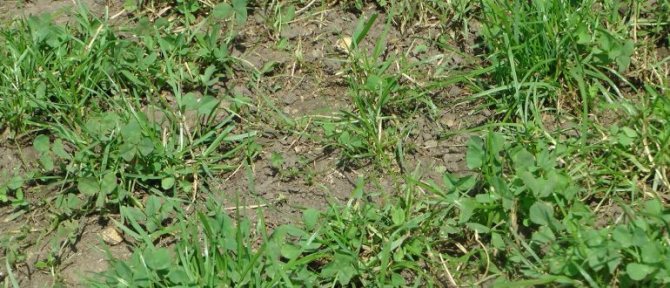

At this time, the young plant feeds exclusively on the protein of the seeds. The opposite end of the seedling, freed from the seed coat, rises vertically and begins to rotate clockwise in search of the host plant. The independent development of dodder seedlings lasts from five days to several weeks, reaching a stem length of 25-30 cm. If during this time the weed does not find an object for "exploitation" that will feed and feed it, it dies.
Having found the "victim", the dodder twines around it with two or three turns and visually seems to suspend its growth. Currently, using nutrients from the lower part of the stem, the seedling of the field dodder, in the places of contact with the affected plant, forms special organs - haustoria (or, more simply, suckers).
With their help, the parasite penetrates deeply into the cambium and the conductive tissues of the damaged plant and begins to absorb water from the plant with nutrients dissolved in it, coming from the soil. With the formation of haustoria, the seedling loses its connection with the soil and completely switches to a parasitic way of life.
We offer you to familiarize yourself with Demodecosis eyelids effective treatment
Having fixed itself on the host plant, the parasite (field dodder) gradually twists around it in a spiral, branches and passes to neighboring plants. The field dodder is characterized by practically unlimited growth and the ability to branch, and therefore one specimen of the parasite (field dodder) can entangle dozens of neighboring plants in a relatively short period. As a light-loving species, the field dodder develops in the middle and upper tiers of plants.
In the second half of summer, as the activity of vegetative growth of plants comes and subsequently this process stops, the supply of nutrients to the dodder stems also decreases. Its vegetative growth also gradually ends, and the plants move on to flower formation (i.e. generative growth) and fruiting.
Dodder flowering, a parasite plant, is observed in June - August, while fruiting continues from July to late autumn. Usually, the flowering period depends on the germination time of its seeds - in the spring or later in the summer. Warm weather promotes earlier mass flowering, while cool weather delays it.
It should be noted that during the period of fruiting in the stems of dodder, the content of chlorophyll increases insignificantly, pores are formed, especially in haustoria and pedicels, which makes it possible for plants to assimilate carbon dioxide, synthesize and deposit reserve nutrients in seeds. The seeds ripen two to three weeks after the beginning of flowering, and crumble in late autumn. One plant forms up to 15 thousand or more seeds, which remain viable in the soil for six to seven years.
Contraindications and side effects
It is not recommended to use dodder as a remedy in the following cases:
- during pregnancy and lactation;
- in childhood (up to 12 years old);
- with increased allergic mood;
- with individual intolerance to plant components.
Side effects include headaches, dizziness, nausea and vomiting. To prevent the development of undesirable effects, the plant is recommended to be used in accordance with the recommendations and dosage.
Preventive measures against reappearance
It is important not to allow the secondary introduction of the parasite to summer cottages. To do this, you need to carefully check the planting material (seedlings and seeds) for the presence of weeds. The difficulty lies in the similarity of dodder seeds and horticultural crops. Better to buy them in specialized stores. It is not recommended to apply fresh manure, because poisonous seeds do not die in the digestive tract of cattle.
Very often, the pest crawls into the gardens from the side of the road, located next to the road. It is necessary to mow and burn the thickets entangled in the "yellow" within a radius of several meters from the home territory.
The land from wastelands, forest belts and weedy meadows is not suitable for summer cottages, it is filled with weed seeds. Before working in the garden and vegetable garden, clean equipment and shoes should be used.
Procurement of raw materials
To preserve the healing properties of the plant, you must follow the recommendations for its collection:
- dodder gathers away from industrial enterprises and highways;
- for medicinal purposes, the entire part of the weed is collected;
- the stem of the plant is harvested in June-July;
- dodder seeds are harvested in the fall;
- the root is harvested before the dodder begins to parasitize.
It is necessary to dry parts of the plant in a ventilated area, avoiding direct sunlight and moisture. It is recommended to store in paper bags for no more than 1 year.
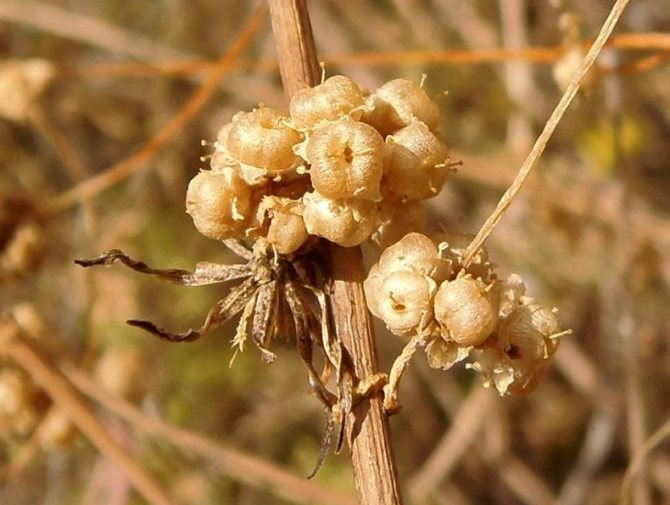

Grass is harvested during flowering in June-July, seeds - after the end of the growing season, usually in autumn

